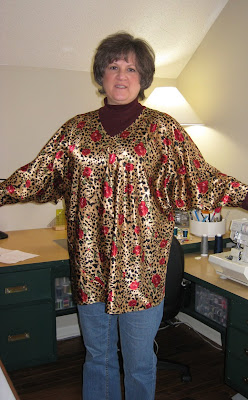I haven't talked about the blue river quilt lately. You remember, the the art quilt I have been working on for a year and a half! I finished the quilting on it last February (2009) and began embellishing it.
First, I did some big stitches on the trees with pearle cotton.

I hated it! So I ripped it out.

This is how the piece looked after quilting at the beginning of the embellishment stage, with only that one tree done, and even that one was later 'undone'. The colors here look odd, though!
Next I tried just stitching on ONE side of the trees and I liked that better.

I applied beading along the rays of the sun and various other places. This took months, as I generally only worked on this on Mondays, and not every Monday at that!

When I was trimming the quilt after the initial line of stitching to put on the binding, I accidently cut off a corner of the binding. Arrrgh!
*
*
*
*
*
*
*
*
*
*
*
*

This was supposed to be a continuous binding atround this corner, not one that starts and stops! It is NOT supposed to have two halves! So I had to rip off a big section of the binding and make a new section for that corner. Fortunately, the binding was pieced from a variety of pieces anyway, so this won't be seen as a mistake.
*
*
*
*

This is how the quilt looked in October of 2009...I was trying so hard to call it finished!
I sewed with pearle cotton...I ripped out pearle cotton.
I sewed on beads...I took off beads.
SOMETHING about it still bothered me, but I was so sick of looking at it that I just put it away and called it 'done'.
*
*
*
*
*
*
*
*
*
*

This is the lower half of the quilt...this is the area that bothered me the most. In addition to being so much lighter in color than the majority of the background, the piecing was also 'chaotic'...seams going in all directions...as opposed to neat and orderly like the seams in the upper areas of the background. Plus, the leaves and flowers in this lower area were stylistically different from the background trees. At first, I liked that, but it later began to bother me.
I had tried scattering beads along the river bank, like flotsom and jetsom, but that didn't give me the satisfaction I hoped for!
Even the cute turtle bead was later removed.
So I decided to
paint the background of the lower right section! (what?)
First I used a very watered-down solution of DynaFlow to darken the light areas a bit. Better, but not enough.

I used some colored pencils and crayons to color in the quilting, to see if I might want to REALLY do some painting...with Shiva paintstiks. I decided that, NO, that wasn't the look I was after either.
By now, it is 2010, so the label on the back that says this was finished in 2009 will certainly have to be changed!
I recently decided that the way to fix this quilt was to
whack off the lower part! Now, this was a difficult decision. I have never done anything like this before and was not sure whether or not I would ruin the whole thing by doing this!
But I did it. And it wasn't too bad...not too hard! I ripped some of the binding on each side then cut the quilt off where desired...then I rebound the lower edges on each side of the 'river'. Since I didn't want binding around the river itself, I undid some of the quilting in that area so I could turn under the cut edges of the quilt and the background and slipstitch them together for a clean edge. Then I reapplied the fuzzy yarn that surrounds the river edge (also by hand).
I removed the remaining pearle cotton stitches in those upper trees and added beads instead, also beading the remaining trees that were 'beadless'.
Now all trees had beads...it made more sense.

Then I decided to add beads to the water! I beaded for about an hour and (at left) is what I had:
I hated it. I was about to rip it out when I talked myself into waiting...telling myself , "Perhaps do a little more and then you'll like it."
So I did more.
I worked on this quilt for 4 days last week...or was it 5 days? It was ALOT! But I was more pleased with the overall result at this point and was trying so hard to get it finished!
Until I began beading the river, that is!
*
*
*
*
*
*
*
*
*
*

I had purchased several types of beads, since there was no pre-mixed packagesin the colors I needed at my local Hobby Lobby. I even got some sequins, just to jazz it up a bit!
*

This is where it stands today...Monday afternoon.
I am once again NOT pleased.
I think the beading on the water is NOT good....not a good thing.
I am pretty sure I liked it better without any beads on the blue water.
I am CERTAIN that I want to remove the small, 'S' shaped cluster near the bottom...but nearly as sure of removing them all.
I am forcing myself to sleep on it.
 On Friday, like much of this country's midsection, we got blasted with a wintery mix. It rained and sleeted and snowed and sleeted and was just generally COLD. Great days to stay in side and sew, though!
On Friday, like much of this country's midsection, we got blasted with a wintery mix. It rained and sleeted and snowed and sleeted and was just generally COLD. Great days to stay in side and sew, though!









































